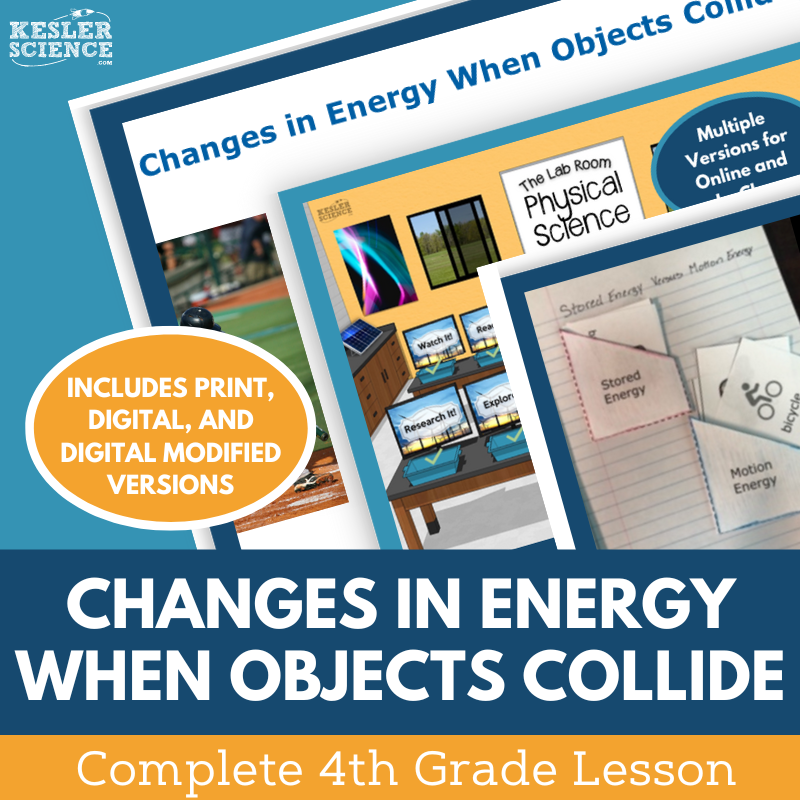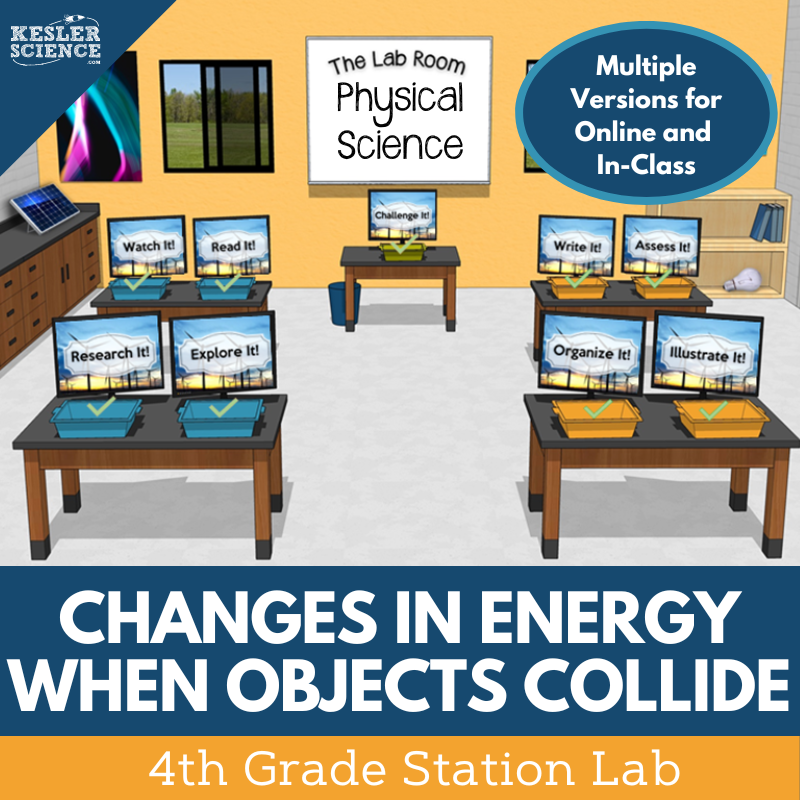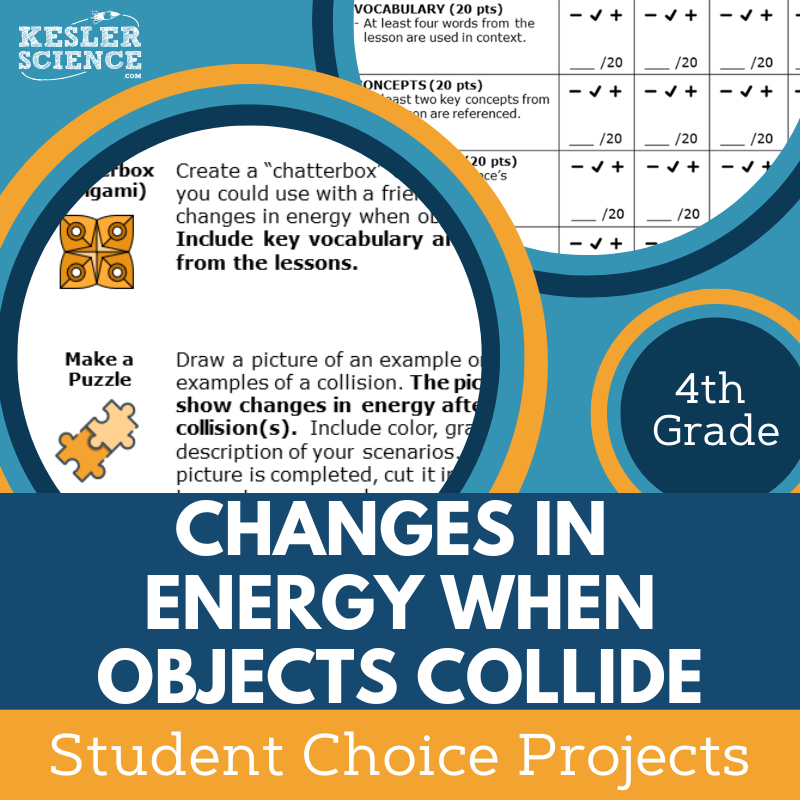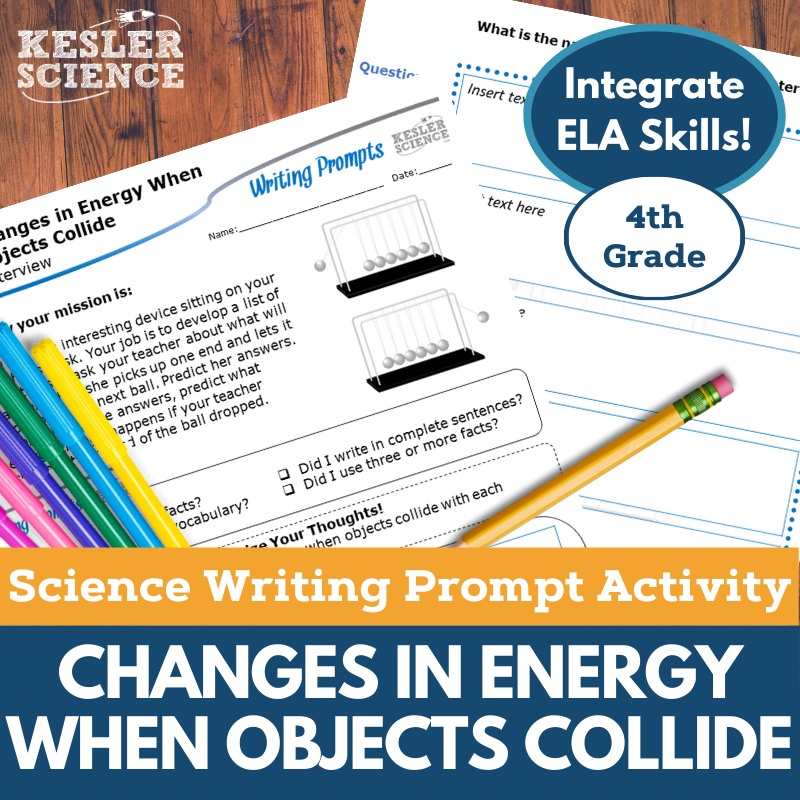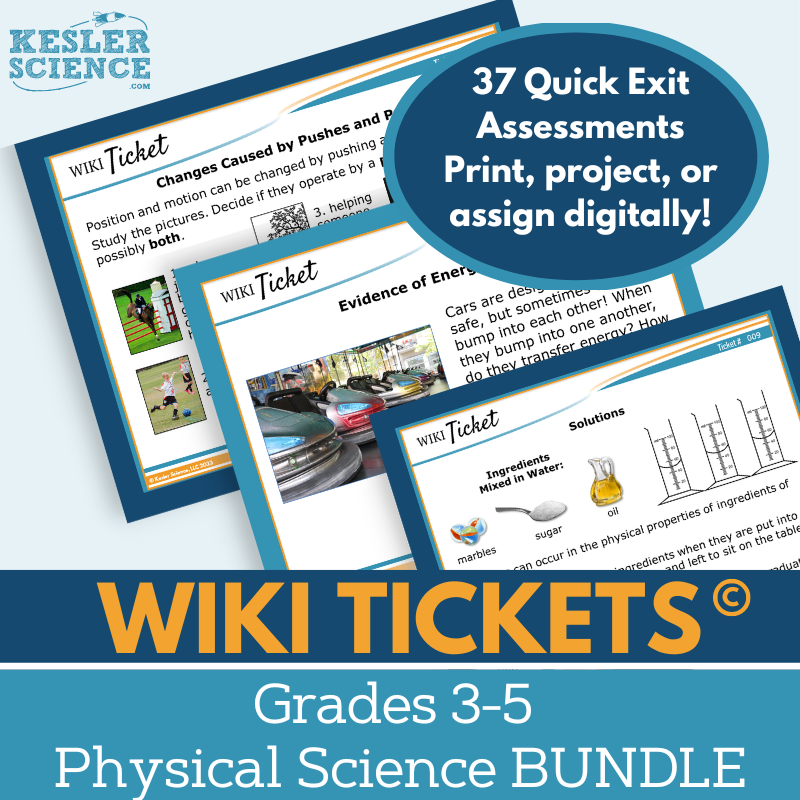Energy & Collisions Activities for 4th Grade Science
Discover how energy changes when objects collide with this engaging 5E lesson aligned to NGSS 4-PS3-3. The resources below will give students a comprehensive understanding of energy and collisions. All of the following materials are also included in the Kesler Science Membership.
The Kesler Science Changes in Energy When Objects Collide 5E Lesson is a comprehensive unit on how energy changes when objects collide, aligned with NGSS 4-PS3-3. It includes editable presentations, worksheets, choice projects, assessments, and Spanish translations for key materials. Designed for differentiated, student-led learning, the lesson is flexible for digital or printable use and requires minimal prep.
Following the 5E Model, the unit engages students with discussion-based activities and vocabulary support in English and Spanish. Exploration is driven by a student-led station lab with multimodal input and output stations, allowing hands-on experiments, reading comprehension, research, video analysis, and creative responses. A bonus challenge station offers extension activities. Explanation features editable PowerPoints, interactive notebooks, and note-taking templates. Elaboration includes student-choice projects to reinforce learning, while Evaluation provides STAAR 2.0-aligned assessments and review materials.
This resource is fully adaptable for both in-person and virtual learning, ensuring accessibility and engagement across different instructional settings.
The Kesler Science Changes in Energy When Objects Collide 5E Lesson is a comprehensive unit on how energy changes when objects collide, aligned with NGSS 4-PS3-3. It includes editable presentations, worksheets, choice projects, assessments, and Spanish translations for key materials. Designed for differentiated, student-led learning, the lesson is flexible for digital or printable use and requires minimal prep.
Following the 5E Model, the unit engages students with discussion-based activities and vocabulary support in English and Spanish. Exploration is driven by a student-led station lab with multimodal input and output stations, allowing hands-on experiments, reading comprehension, research, video analysis, and creative responses. A bonus challenge station offers extension activities. Explanation features editable PowerPoints, interactive notebooks, and note-taking templates. Elaboration includes student-choice projects to reinforce learning, while Evaluation provides STAAR 2.0-aligned assessments and review materials.
This resource is fully adaptable for both in-person and virtual learning, ensuring accessibility and engagement across different instructional settings.
Engage your 4th-grade students with this interactive, student-led station lab on Changes in Energy When Objects Collide. Designed for in-class or virtual learning, this lesson encourages students to ask questions and predict outcomes through nine differentiated stations featuring videos, readings, research, hands-on tasks, and assessments.
Students demonstrate their understanding by organizing information, illustrating models, writing responses, and completing assessments. A bonus challenge station provides extension activities for advanced learners. English and Spanish reading passages support differentiated learning, and the modular design allows for independent or small-group work with minimal teacher direction.
This low-prep, high-engagement resource promotes active learning and critical thinking while providing a multimodal approach to exploring energy changes during collisions.
Engage your 4th-grade students with this interactive, student-led station lab on Changes in Energy When Objects Collide. Designed for in-class or virtual learning, this lesson encourages students to ask questions and predict outcomes through nine differentiated stations featuring videos, readings, research, hands-on tasks, and assessments.
Students demonstrate their understanding by organizing information, illustrating models, writing responses, and completing assessments. A bonus challenge station provides extension activities for advanced learners. English and Spanish reading passages support differentiated learning, and the modular design allows for independent or small-group work with minimal teacher direction.
This low-prep, high-engagement resource promotes active learning and critical thinking while providing a multimodal approach to exploring energy changes during collisions.
The Changes in Energy When Objects Collide Student Choice Projects allow 4th-grade students to demonstrate their understanding in a way that suits their preferred output style. A project page presents six student-led options and a “design your own” project, with an editable rubric for teacher, peer, or self-assessment.
These flexible, multimodal projects offer creative ways for students to showcase their learning. Two versions of the project page support differentiation, with modified options for students needing remediation and opportunities for advanced learners to complete multiple projects using the same rubric.
The projects use standard classroom supplies such as paper, markers, and scissors, with many options available for digital completion. Some crafting supplies may be helpful for model-building.
The Changes in Energy When Objects Collide Student Choice Projects allow 4th-grade students to demonstrate their understanding in a way that suits their preferred output style. A project page presents six student-led options and a “design your own” project, with an editable rubric for teacher, peer, or self-assessment.
These flexible, multimodal projects offer creative ways for students to showcase their learning. Two versions of the project page support differentiation, with modified options for students needing remediation and opportunities for advanced learners to complete multiple projects using the same rubric.
The projects use standard classroom supplies such as paper, markers, and scissors, with many options available for digital completion. Some crafting supplies may be helpful for model-building.
The Changes in Energy When Objects Collide science writing activity engages 4th-grade students in an interactive interview-style Q&A format to explore physical science concepts. Designed for both print and digital use, this TEKS- and NGSS-aligned activity enhances science reasoning and writing skills, making it ideal for in-person or virtual learning.
This resource includes teacher directions with answer guides, project ideas, and rubrics, along with projection-friendly and full-sized handouts featuring writing prompts, self-check tools, and pre-writing strategies. A half-sheet version is also available for interactive notebooks, and a digital interactive version in PowerPoint and Google Slides supports remote learners.
Perfect for cross-curricular activities, pre-test assessments, student choice projects, early finisher enrichment, extra credit, make-up work, and differentiation, this engaging writing prompt encourages creativity and scientific inquiry.
The Changes in Energy When Objects Collide science writing activity engages 4th-grade students in an interactive interview-style Q&A format to explore physical science concepts. Designed for both print and digital use, this TEKS- and NGSS-aligned activity enhances science reasoning and writing skills, making it ideal for in-person or virtual learning.
This resource includes teacher directions with answer guides, project ideas, and rubrics, along with projection-friendly and full-sized handouts featuring writing prompts, self-check tools, and pre-writing strategies. A half-sheet version is also available for interactive notebooks, and a digital interactive version in PowerPoint and Google Slides supports remote learners.
Perfect for cross-curricular activities, pre-test assessments, student choice projects, early finisher enrichment, extra credit, make-up work, and differentiation, this engaging writing prompt encourages creativity and scientific inquiry.
The WIKI Tickets© Physical Science Set provides engaging, flexible formative assessments for 3rd–5th grade science. This set includes 37 exit tickets, each available in five formats: a full-screen projection version, three printable handouts, and an interactive digital version compatible with PowerPoint and Google Slides.
Aligned with NGSS and TEKS standards, these assessments cover key physical science topics, including forces and motion, energy transformations, states of matter, circuits, mixtures, and gravitational force. Each standard has at least one ticket, and some topics feature multiple assessments. A bonus table of contents file is included to show alignment.
WIKI Tickets© can be used in both in-person and virtual learning settings. Students can respond on printed handouts, their own paper, or digitally in a 1:1 or remote environment. These colorful, engaging assessments work as exit tickets, bellringers, or quick checks to gauge student understanding at any time.
The WIKI Tickets© Physical Science Set provides engaging, flexible formative assessments for 3rd–5th grade science. This set includes 37 exit tickets, each available in five formats: a full-screen projection version, three printable handouts, and an interactive digital version compatible with PowerPoint and Google Slides.
Aligned with NGSS and TEKS standards, these assessments cover key physical science topics, including forces and motion, energy transformations, states of matter, circuits, mixtures, and gravitational force. Each standard has at least one ticket, and some topics feature multiple assessments. A bonus table of contents file is included to show alignment.
WIKI Tickets© can be used in both in-person and virtual learning settings. Students can respond on printed handouts, their own paper, or digitally in a 1:1 or remote environment. These colorful, engaging assessments work as exit tickets, bellringers, or quick checks to gauge student understanding at any time.
Year-Round Resources
These year-round activities will increase your students' understanding of many middle school science topics. All of these activities are also included in the Kesler Science Membership.
Visual Data & Graphing
You're not alone if your students struggle with understanding graphs, charts, and tables. It's a skill that takes an enormous amount of practice. This resource will help students build a strong foundation in analyzing data and creating their own data visualizations.
Bell Ringers and Warm-Ups
These middle school science bell ringers are an excellent way to engage your students as soon as they walk into your classroom. This comprehensive FULL YEAR resource includes everything you need to start off each science class with an interesting warm-up activity.
Review Board Games
Each game board has been carefully designed to keep students engaged. There are 10 different action spaces on each board and dozens of question cards. All of the actions are related to science concepts and keep the students motivated throughout the game.
Each game is ready to play. Simply print out the board and the cards and let the students enjoy reviewing nine different units.
Essential Questions and Standards
Below are the essential questions and standards associated with the lessons and activities included in the energy and collisions unit. This topic is only one of more than 100 middle school science topics included in the Kesler Science Membership.
-
What happens to the energy in one object when it collides with another object?
-
What observations can we make that would show that energy is present when two objects collide?
-
NGSS - 4-PS3-3 Energy & Collisions
Kesler Science Membership
Imagine never having to search for another middle school science lesson again. The membership gives you access to ALL of the Kesler Science products in one place (Yes, including everything above).
Say goodbye to long hours of lesson prep.

